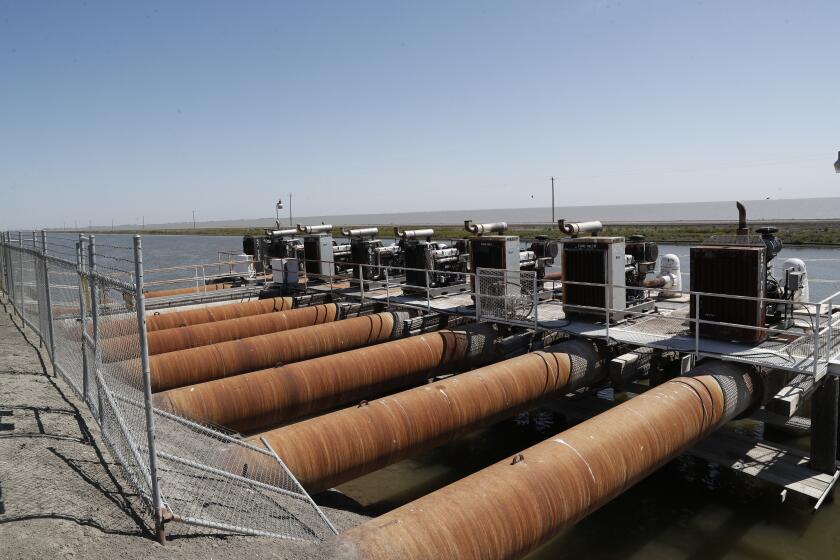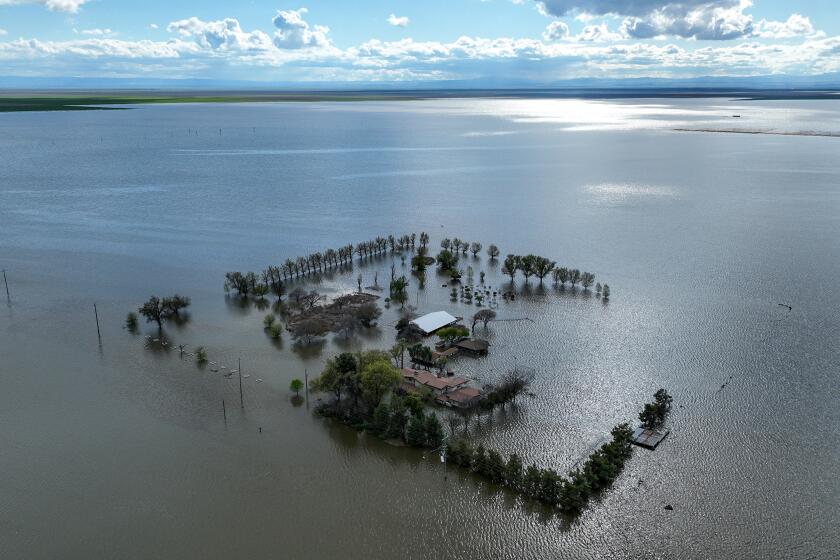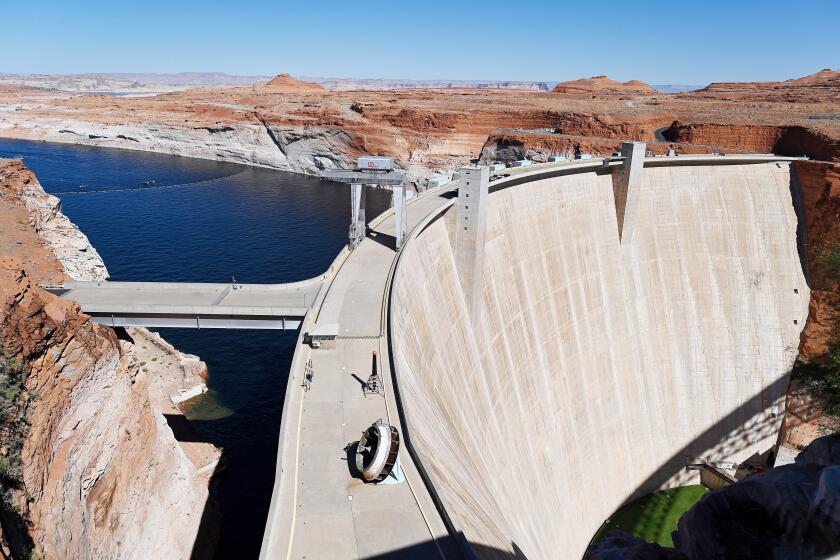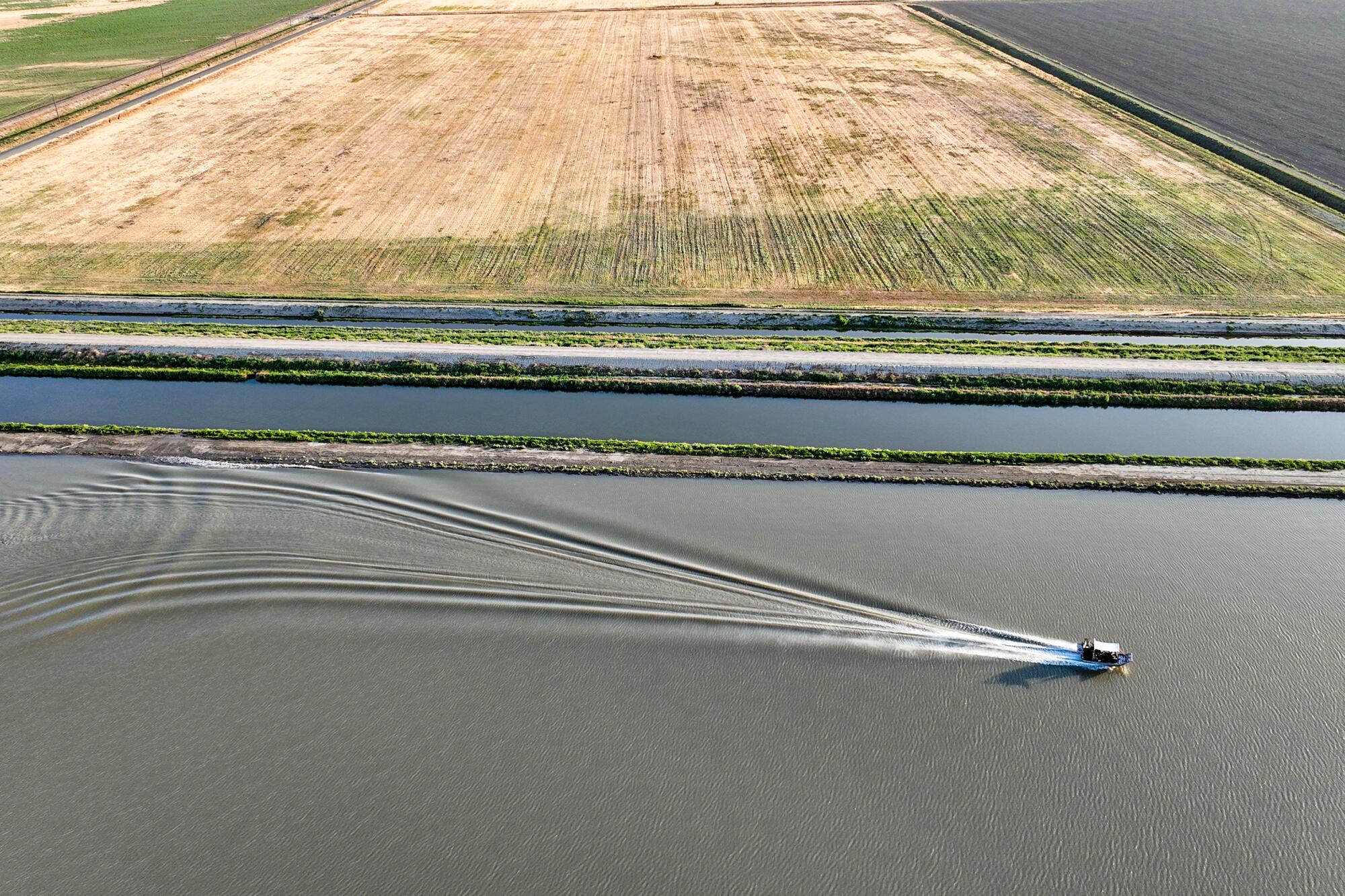
- Share via
SACRAMENTO — For the first time, California water regulators are cracking down on one of the state’s major farming regions for failing to take steps to curb growers’ excessive groundwater pumping, which has sent water levels into rapid decline and is causing the land to sink.
The State Water Resources Control Board voted unanimously Tuesday to place the Tulare Lake subbasin on “probationary” status for failing to adopt sufficient measures to address chronic overpumping.
For the record:
1:28 p.m. April 18, 2024A previous version of this article said the Tulare Lake basin was put on probation for failing to adopt sufficient measures to address chronic groundwater overpumping. The Tulare Lake subbasin, which is part of the the Tulare Lake basin, was the area put on probation.
Aggressive and impactful reporting on climate change, the environment, health and science.
Falling groundwater levels have caused the ground to sink as much as 6 feet in parts of the area over the last decade, and state officials have determined that a local plan for managing groundwater would allow the free fall to continue. They say that without stronger measures, hundreds of household wells are at risk of running dry.
It’s the first time California officials have used their authority to intervene in a community to force stronger measures to rein in the depletion of groundwater, as required under the state’s decade-old Sustainable Groundwater Management Act, known as SGMA.
“The goal here is to set folks up for success locally. We recognize this is a really hard job,” board member Laurel Firestone said before the vote. “When these decisions are this big and this hard, sometimes it falls on the state to be the backstop, and that’s what I think we need to do.”
Now that the area in the southern San Joaquin Valley has been placed on probation, large agricultural landowners will be required to start reporting to the state how much water they pump from wells and paying fees based on how much they use.
The vote came at the end of a daylong meeting in Sacramento during which farmers and representatives of local groundwater agencies urged the state water board to postpone the intervention and give them more time to improve their local plan for moving toward sustainable groundwater management.
Toward a more sustainable California
Get Boiling Point, our newsletter exploring climate change, energy and the environment, and become part of the conversation — and the solution.
You may occasionally receive promotional content from the Los Angeles Times.
Farmer Doug Freitas told the board that the “excessive costs” will severely harm the farming community.
“Don’t allow SGMA to kill, steal and destroy our lives,” Freitas said. “We the people of this great state of California would like to ask for additional time to solve these issues that need to be corrected.”
But board members said the state needs to step in.
“The goal here is to not be punitive in the least,” said Joaquin Esquivel, the board’s chair.
“The reality is that probation is a step,” Esquivel said. “It’s a process that ultimately is about local control.”
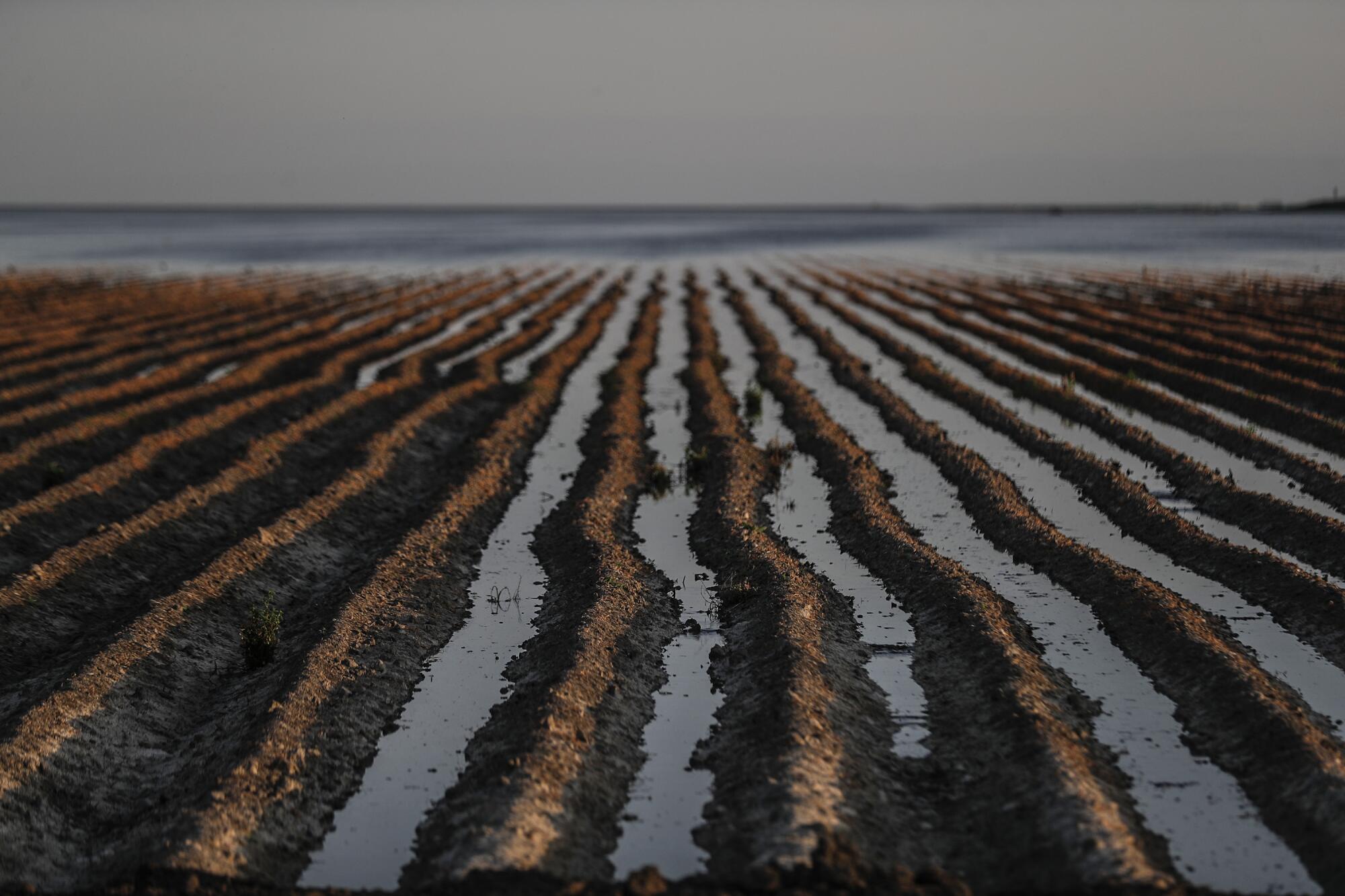
The Tulare Lake subbasin, which is part of the larger Tulare Lake basin, is one of six areas in the San Joaquin Valley where local groundwater plans have been deemed inadequate by the state.
Under the state’s 2014 groundwater law, the five local groundwater agencies in the area are required to develop a plan for reducing pumping and curbing chronic declines in groundwater levels by 2040.
But the state water board’s staff last year recommended probationary status after finding the local plan didn’t include adequate measures to stop declines in water levels and the related problem of sinking ground, among other problems.
The land has been rapidly sinking in areas around the city of Corcoran. The levees that protect Corcoran from flooding have had to be raised twice in the last decade, including last year, when the long-dry Tulare Lake reappeared on thousands of acres of farmland.
“There have been and continue to be really severe impacts on people,” Firestone said. “Although changing and reducing pumping will have really severe impacts, doing nothing and continuing the status quo has already — and will continue to — have real impacts to communities, to the community infrastructure, to livelihoods. And so we’re doing this, I think, because we all recognize that we don’t have a choice.”
The farm barons of Tulare Lake Basin want to continue pumping groundwater at volumes collapsing the San Joaquin Valley. That puts the region at greater risk of damaging floods — and in greater need of taxpayer bailouts.
The decision represents the first phase of what could be a two-step process of state intervention. State officials say they will work with the five local groundwater sustainability agencies to collect data and develop a workable plan.
The area will be on probationary status for a year. Most well owners will be required to start reporting how much they use, while those pumping more than 500 acre-feet per year must install meters on their wells. Well owners also will be required to pay the state $300 per well plus a pumping fee of $20 per acre-foot, a measure intended to cover costs related to the state’s intervention.
“The first step we’re doing is getting information, getting a handle on what’s going on. That’s what probation means,” Firestone said. “We have to come to grips with where are the wells, how much is being pumped.”
The goal, state officials said, is to work with the local agencies to improve their plan so that state intervention is no longer needed.
But if the local agencies fail to address the deficiencies in their groundwater plan, the state water board would move into a second phase involving stronger intervention. State officials could then consider whether to impose pumping restrictions or issue fines when pumping exceeds limits.
State officials estimated that the local agencies’ plan would allow for continued declines in groundwater levels that would put about 700 domestic wells at risk of drying up.
“Groundwater supplies in the Tulare Lake basin are clearly at risk, and we are acting today to protect this resource because communities rely on it for basic needs, in particular drinking water,” Esquivel said. “Our goal remains that these basins be managed sustainably at the local level, and we are committed to helping groundwater agencies make that happen by providing data, guidance and support as they improve their plans.”
Land barons seized control of the Tulare Lake Basin generations ago. This year’s destructive flooding left troubling questions about the power they wield.
In the hearing room Tuesday, farmers in baseball hats and cowboy boots mostly sat in the back, while lawyers and water officials sat toward the front.
Many farmers said they understand that managing groundwater is vital for the area’s future, but they argued that the way the state is intervening could threaten their livelihoods. They said they wanted the board to understand how hard it is to run a farm in California while also dealing with inflation and low commodity prices. Some said regulation that makes water more expensive could put them out of business.
Garrett Gilcrease, a farmer who said his ancestors started farming in Kings County in 1883, said he is worried that state intervention could be the start of changes that make it untenable for growers’ businesses to survive. He said he had brought a list of his longtime employees with him, “but if I can’t farm, I can’t keep them.”
Some said they’re concerned that small-scale farmers could be hit harder by fees and other measures.
“The water situation in the valley has long been ignored. And now we are facing a crisis,” said Jacqueline Lowe, who farms walnuts on 44 acres.
She said small farms like hers haven’t been a major culprit. “I think we have to look now at the large corporate farms in Kings County that have for decades changed the natural pattern of waterways, built dams to divert water for their use, and drained areas that historically retained excess water,” she said.
Industrial-scale agriculture has reshaped the southern San Joaquin Valley over the last century. Tulare Lake was once the largest freshwater lake west of the Mississippi River, but it was drained generations ago to serve agriculture.
Fields across the ancient lake bottom have been transformed into lucrative plots for tomatoes, cotton, hay and other crops.
Last year, the lake reappeared during one of the wettest winters on record. For the first time in 25 years, floodwaters covered thousands of acres of cropland, and the water surged onto lands that hadn’t previously flooded, where the ground had sunk because of groundwater pumping.
Tulare Lake grew nearly as large as Lake Tahoe for a time. But by the end of January, the lake had receded, its surface falling below the state’s water elevation sensors.
Much of the lake bed sits on a thick layer of clay that blocks water on the surface from percolating down to the aquifer.
Agriculture accounts for the vast majority of the area’s water use. And state officials have estimated that 215,000 acre-feet of groundwater is drained from the area’s aquifer per year — roughly 40% of the total annual water use of Los Angeles.
Some growers said the answer to the groundwater problem lies partly in capturing and storing more water from rivers when flows are available.
J.G. Boswell Co., the area’s largest agricultural landowner, objected to the state’s process, saying in a letter to the board last year that the company is concerned about how a probationary determination “will impact its operations” and believes state officials’ draft report contained false assumptions and “many deficiencies.”
Dusty Ference of the Kings County Farm Bureau challenged what he said was the state’s “misapplication” of the law, saying the intervention would bring an “economic train wreck of fallowed farmland.”
He called the fees that the state plans to charge “arbitrary and excessive.”
“SGMA requires sustainability by 2040, not today,” Ference said. “Let’s take a little more time since we both need to get this right, rather than being driven into administrative and judicial conflict.”
Newly discovered damage in Glen Canyon Dam would require releasing less water at low reservoir levels — a problem that increases water risks in the Southwest.
However, others said they support the state’s intervention.
“I’m not against the state coming in and giving us guidance,” said Doug Verboon, a Kings County supervisor. “We’re all having a tough time.”
Tien Tran, a policy advocate for the Community Water Center, supported placing the area on probation.
“Over 700 wells are susceptible to going dry, and having up to 6 feet of subsidence is unacceptable,” Tran said. “This is a critical moment, where the state water board must follow the law and do the right thing.”
Other advocates said that managing groundwater sustainably is a vital part of making the area more resilient to the effects of climate change, and that as limits on pumping take effect, some farmland can be converted to other uses, such as wetland habitats.
“They’re farming on a lake that they pumped down, and now this lake is trying to reoccur,” said Fred Briones, a member of the Big Valley Band of Pomo Indians. “The ground is collapsing underneath their feet.”
State officials said the local groundwater plan also must have adequate measures to address potential degradation of water quality linked to overpumping.
By placing the region on probation, the state water board is laying the groundwork for similar measures in other farming areas. In September, the board is set to consider whether to place the nearby Tule subbasin on probationary status.
Leaders of the Tulare Lake region’s local groundwater agencies said they are working on a revised plan that addresses state officials’ concerns.
Members of the state water board said they were encouraged to hear the local agencies are making progress in strengthening their plans, but still thought intervention is needed.
After hearing from local officials, board member Sean Maguire quipped: “You’re the guinea pig. And apologies for that, but someone had to go first.”
More to Read
About this report

